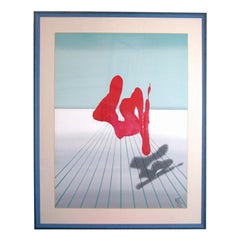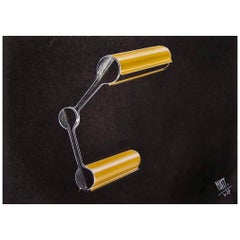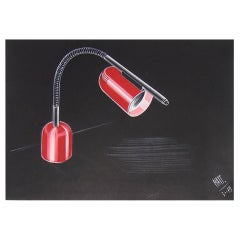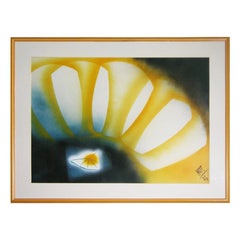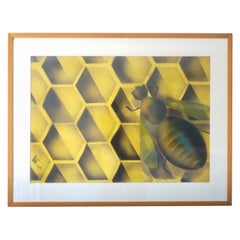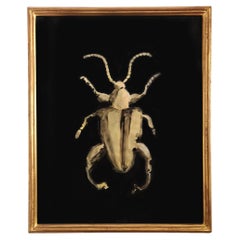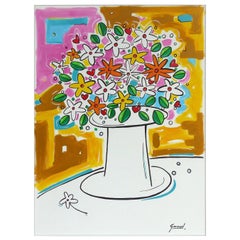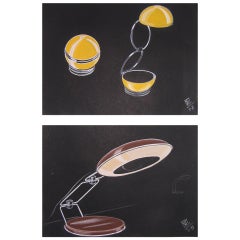Luciano Mattioli Furniture
Luciano Mattioli was a very versatile and prolific artist on the Italian and French design scene. He was a designer for Philips and Grundig and an exclusive designer in the 1970s for the Italian Company Girmi. Mattioli exhibited in Milan during the 1980s.
to
5
5
5
4
Dated 1980 Abstract Gouache Painting by Italian Designer Luciano Mattioli
By Luciano Mattioli
Located in New York, NY
Painting dated 1980 and signed by the Italian designer, inventor and painter Luciano Mattioli (1924-1994,) a very versatile and prolific artist on the Italian and French design scene...
Category
Late 20th Century Italian Luciano Mattioli Furniture
Materials
Acrylic, Wood
1979, Italian Design Drawing Sketch for a Desk Light Project by Luciano Mattioli
By Luciano Mattioli
Located in New York, NY
Dated mid-20th century industrial hand drawing, highly collectible Italian modern Product Design for a lacquer yellow desk light project, realized without ruler in pastels and gouach...
Category
1970s Italian Mid-Century Modern Vintage Luciano Mattioli Furniture
Materials
Crayon, Paint, Paper
One 1979 Mattioli Italian Design Drawing for a Modern Red Desk Light Project
By Luciano Mattioli
Located in New York, NY
Dated mid-20th century industrial hand drawing, highly collectible Italian modern Product Design for a lacquer red desk light project, realized without a ruler in pastels and gouache...
Category
1970s Italian Mid-Century Modern Vintage Luciano Mattioli Furniture
Materials
Crayon, Paint, Paper
Vintage Abstract Painting by Luciano Mattioli
By Luciano Mattioli
Located in New York, NY
An abstract painting dated and signed by the Italian designer, inventor and painter Luciano Mattioli (1924-1994), a very versatile and prolific artist on the Italian and French desig...
Category
1970s Italian Vintage Luciano Mattioli Furniture
Materials
Acrylic
Mattioli Italian Vintage Yellow Black Acrylic & Watercolor Modern Painting
By Luciano Mattioli
Located in New York, NY
Spray paint Art dated 1974 and signed by the Italian designer, inventor, and painter Luciano Mattioli (1924-1994). This postmodern painting, from a...
Category
1970s Italian Post-Modern Vintage Luciano Mattioli Furniture
Materials
Wood, Paint, Paper
Related Items
Scarabeo Watercolor Painting
By Buenaventura
Located in Madrid, ES
This charming and sophisticated wall decoration has been entirely hand-painted on 100% natural cotton paper, using the sumi-e technique inspired by ancient Korean paintings. Particul...
Category
21st Century and Contemporary Spanish Modern Luciano Mattioli Furniture
Materials
Cotton, Acrylic, Paper
Vintage Abstract Floral Still Life Painting, "Love" by Garmed
By Garmed
Located in Miami, FL
Vintage Abstract Floral Still Life Painting, "Love" by Garmed
Offered for sale is an original acrylic on canvas titled “Love” by Venezuelan born Miami resident artist Garmed, Alfr...
Category
21st Century and Contemporary American Modern Luciano Mattioli Furniture
Materials
Canvas, Acrylic
$1,800 Sale Price
28% Off
H 49 in W 37 in D 2.12 in
Framed Surrealistic Drawing by Pedro Friedeberg
By Pedro Friedeberg
Located in Atlanta, GA
Artist: Pedro Friedeberg (Mexican, 1936-)
Title:Le Tombeau D'Hemingway
Year: 1963
Medium: Ink and watercolor on paper:
Size: 14 3/4 x 19 1/2 plus 3 inch frame
Mark: upper lef...
Category
1960s Mexican Modern Vintage Luciano Mattioli Furniture
Materials
Paper
Constructivist abstract gouache by Boris Alepkow
Located in San Francisco, US
This Constructivist abstract gouache by Boris Alepkow, circa 1960s, features layered geometric forms in teal, red, orange, dark green, and white arranged across a textured, sand‑tone...
Category
Mid-20th Century Russian Bauhaus Luciano Mattioli Furniture
Materials
Paper
Chinese Watercolor Painting
Located in Los Angeles, CA
Antique Chinese watercolor painting on paper, enclosed in glass and gilt wood frame, early 20th century
Measures: height 27.5 inch...
Category
Early 20th Century Chinese Luciano Mattioli Furniture
Materials
Glass, Wood, Paper
Italian Abstract Expressionist Painting by Ugo Sterpini, Signed and Dated 1958
Located in Stamford, CT
Ugo Sterpini (Italian, 1927-2000)''La Lotta Sulla Duna" (The Battle On The Dune). Mixed media on canvas, signed and dated ''58'' lower right, signed, titl...
Category
Mid-20th Century Italian Mid-Century Modern Luciano Mattioli Furniture
Materials
Canvas
$2,450
H 23.75 in W 29.5 in D 1 in
Vintage 1960s Abstract Painting by John Popovic
Located in Oxnard, CA
Here is a stunning and powerful painting by Montreal artist, John Popovic. The work features deep dark blacks, contrasted with splashes of red, orange and...
Category
Mid-20th Century Canadian Mid-Century Modern Luciano Mattioli Furniture
Materials
Paint
Abstract Pastel and Gouache Painting by Edward Wolfe
Located in Pasadena, CA
This abstract painting features lines of gradient blues triangles entangled like festive garlands . Cubism influenced the combination of triangle shapes of different sizes in this artwork . Edward Wolfe is known for semi-abstract figure, still life, landscape and portrait painting and drawing, some cubism.
Edward Wolfe (29 May 1897 – 8 July 1982) was a British artist who was a Portrait, flower, and landscape painter, mainly in oil, illustrator, and draughtsman in pen and ink and pencil. Born in Johannesburg, South Africa, Wolfe came to England and studied at the Slade School 1916–8, having in his native country worked for periods as a child actor and for a jeweler, during which time he had his first serious art lessons with the British painter George Smithard. Whilst at the Slade was invited by Nina Hamnett to join Roger Fry...
Category
20th Century English Modern Luciano Mattioli Furniture
Materials
Wood, Paper
Chinese Watercolor Painting
Located in Los Angeles, CA
Antique Chinese watercolor painting on paper, enclosed in glass and gilt wood frame, early 20th century.
Measures: height 27.5 inc...
Category
Early 20th Century Chinese Luciano Mattioli Furniture
Materials
Glass, Wood, Paper
Vintage Mid-Century Modern Cityscape Painting "Skyline v" by M. Baker Signed
Located in Miami, FL
Vintage Mid-Century Modern Cityscape Oil Painting "Skyline V" by M. Baker Signed and Dated 1978.
Features an impasto on board depiction of Hong Kong's skyline, framed with a antique...
Category
1970s American Mid-Century Modern Vintage Luciano Mattioli Furniture
Materials
Wood, Paint
$610
H 20 in W 24 in D 2 in
Acrylic Painting of Birds by Stephen Kaye
By Stephen Kaye
Located in New York, NY
Charming decorative large scale acrylic painting by noted Canadian artist Stephen Kaye. The paints depicts stylized birds in branches, on an abstract textured paint surface. Signed l...
Category
Late 20th Century Canadian Mid-Century Modern Luciano Mattioli Furniture
Materials
Acrylic
"WD2758 Mona" Abstract Art by M. P. Landis, Warehouse Drawing Series
By MP Landis
Located in New York, NY
An energetic, richly hued abstract work on paper by the artist M.P. Landis. The artist's abstract paintings and works on paper are the type that take form through the artist's layeri...
Category
Early 2000s American Luciano Mattioli Furniture
Materials
Paper
$595
H 8.38 in W 10.25 in D 0.1 in
Previously Available Items
One 1979 Mattioli Italian Design Drawing for a Modern Desk Light Project
By Luciano Mattioli
Located in New York, NY
Dated industrial hand drawings, highly collectible Italian Product Design for a desk light project, free hand illustration in pastels and gouache on black cardboard, by the Italian d...
Category
1970s Italian Mid-Century Modern Vintage Luciano Mattioli Furniture
Materials
Paper, Paint
Luciano Mattioli furniture for sale on 1stDibs.
Luciano Mattioli furniture are available for sale on 1stDibs. These distinctive items are frequently made of paper and are designed with extraordinary care. There are many options to choose from in our collection of Luciano Mattioli furniture, although black editions of this piece are particularly popular. Many of the original furniture by Luciano Mattioli were created in the mid-century modern style in italy during the late 20th century. If you’re looking for additional options, many customers also consider furniture by Lucio Del Pezzo, Bisazza Vetro, and Franklin MInt. Prices for Luciano Mattioli furniture can differ depending upon size, time period and other attributes — on 1stDibs, these items begin at $500 and can go as high as $3,000, while a piece like these, on average, fetch $500.
